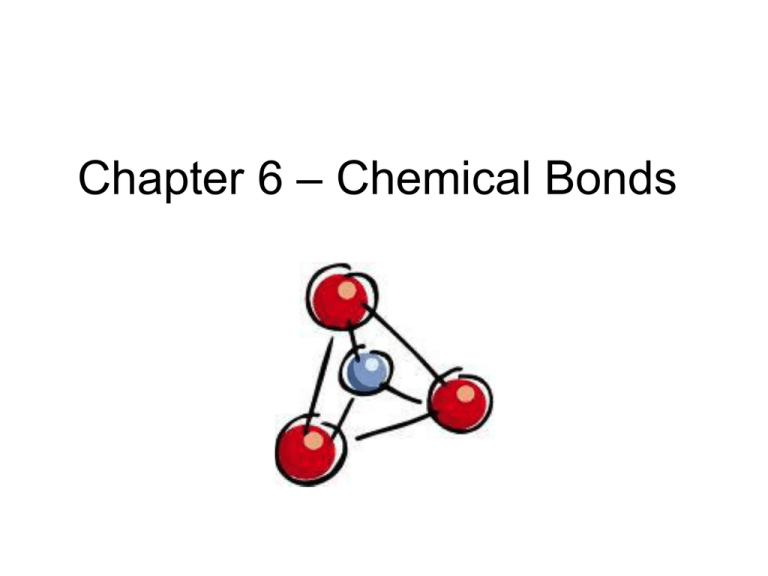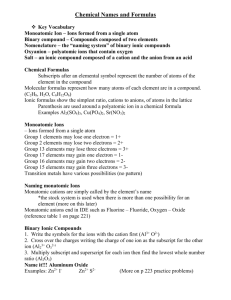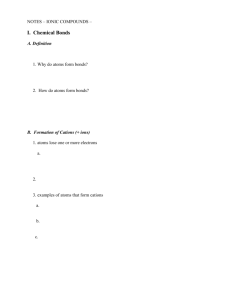Chapter 6 – Chemical Bonds
advertisement

Chapter 6 – Chemical Bonds 6.1 Ionic Bonding • When the highest occupied energy level of an atom is filled with electrons, the atom is stable and not likely to react. • Electron dot diagram – symbol represents the nucleus and each dot represents a valence electron (also called Lewis Dot Diagram or Lewis Dot Structure) Ionic Bonds • Elements achieve stable e- config. through the transfer of e• Form between a metal and a nonmetal • Metal gives up e-; nonmetal gains e• Ions (atoms with charges) are formed • Metal becomes + ion, nonmetal becomes a neg. ion • Opposite charges attract each other Sodium Chloride • Chemical bond – the force that holds atoms or ions together • Cation – positive ion • Anion – negative ion • Ionic bond – the force that holds ions together • Ionization energy – the amount of energy used to remove an e• Lower ionization energy = easier to remove an electron Ionic Compounds • Chemical Formula – shows which elements are in a compound and the ratio – Ex. NaCl, MgCl2 • Crystal lattices – ions are arranged in an orderly, 3-D structure • Crystals – solids whose particles are arranged in a lattice structure • Properties of ionic compounds – High melting points – Poor conductors in solid form – Good conductors when melted – Brittle (shatter when struck by a hammer) When an ionic crystal is struck, ions are moved from their fixed positions. Ions with the same charge repel one another and the crystal shatters. 6.2 Covalent Bonds • Form when two or more atoms SHARE e• Form between two or more nonmetals • Can be polar or nonpolar – Polar – e- are NOT shared equally – Nonpolar – e- ARE shared equally • Form molecules (neutral group of atoms that are joined by covalent bonds) • Atoms may share 1, 2, or 3 prs. of e- Many nonmetals exist as diatomic molecules. Diatomic means “two atoms” Polar Covalent Bonds • One atom has a greater attraction for the e-, making one end of the molecule have a partial neg. charge. The other end has a partial pos. charge. Water is a polar molecule. The e- spend most of their time with the Oxygen atom, making the O end of the molecule slightly negative and the H end slightly positive. Nonpolar Covalent Bond Both atoms have an equal attraction for the electrons, so they share them equally. Attraction Between Molecules • Attractions between polar molecules are stronger than between nonpolar molecules. 6.3 Naming Compounds and Writing Formulas • Binary Ionic Compounds – 1st word – name of metal – 2nd word – name of nonmetal ending in –ide – If the metal is a transition metal, a roman numeral is placed between the metal and nonmetal to indicate which ion. • Ex. Sodium Chloride, Copper (II) Chloride Polyatomic Ions • Covalently bonded group of atoms with a charge. • Polyatomic ions act like single atoms when forming chemical bonds. • Polyatomic ions are COVALENTLY bonded to each other, but as a group they bond IONICALLY to another ion. Writing Formulas for Ionic Compounds • Symbol of cation is written first, followed by the symbol of the anion • Use subscripts to show the ratio of ions • Parentheses are used to enclose polyatomic ions Naming Molecular Compounds • MOST metallic element appears first in the name (the one closer to the left on the periodic table) • If both elements are in the same group, the one closer to the bottom is listed first • Use prefixes to indicate the number of atoms • The prefix “mono-” is not used in the first element name. Writing Molecular Formulas • Write the symbols for the elements in the order that they appear in the name • Use the prefixes to determine the number of atoms • Use subscripts to show how many atoms of each element are in a molecule 6.4 The Structure of Metals • Metallic Bonds – Form between two or more metal atoms – Attraction between the metal cation and the shared electrons that surround it – “sea of electrons” • Metals are malleable and are good conductors because of metallic bonds. • Alloys – Mixture of two or more elements at least one of which is a metal – Can be designed with specific properties by varying the types and amounts of elements in them. Bronze is a common alloy made usually of copper and tin. Steel is an alloy of iron that contains small quantities of iron.



